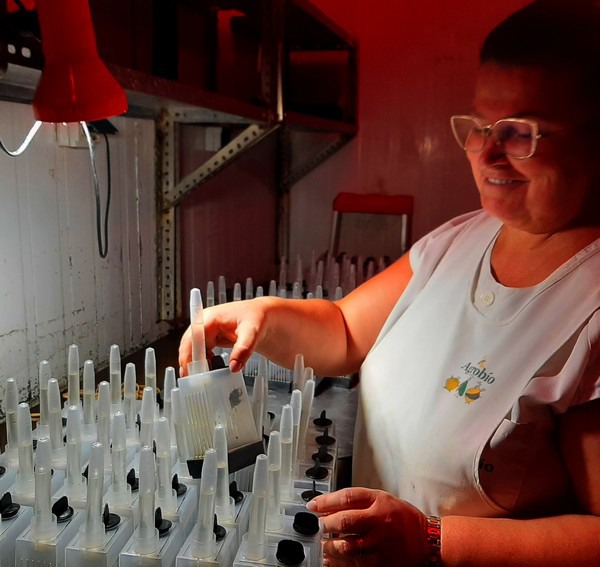In 2005-2006, there was a big problem in Almeria with the control of Frankinela in bell pepper crops. "Some growers, desperate because they could not find any way to combat it, because it had developed resistance to every authorized active material, began to use unauthorized products," said Ana Arevalo from Agrobío's development department. "There was a big alert in Europe that caused the export of peppers from Almeria to be brought to an almost complete halt. It was a turning point for biological control; in fact, in just one year, 90% of growers had switched to the use of beneficial insects."

The roots of biological control in Almeria trace back to the 1990s when bumblebees were first introduced as beneficial insects. Traditionally, phytohormones and chemicals were employed for greenhouse plant pollination due to the inefficiency of bees, particularly with important species like tomatoes. The introduction of Bombus terrestris, or common bumblebees, laid the foundation for integrated control methods. Isabel and Pilar Santorromán of Agrobio take us into Agrobío's bumblebee production facilities in El Ejido. "That's why we started working with the Bombus terrestris or common bumblebee."

"In nature, you only get bumblebee hives during the spring, but in greenhouses, they are needed all year round, so in our production center, we recreate all four seasons simultaneously in different chambers in order to have a continuous hive production."
The fertilization of the queens, which will mother the new hives, takes place in the chamber that recreates autumn.
Each fertilized queen is collected by hand and placed in a box where, after hibernation in the chamber in which winter conditions are simulated, she will wake up and will start laying eggs, producing worker bumblebees, which will be the ones in charge of looking for pollen in the greenhouses to feed the rest of the hive, thereby fertilizing the flowers. "We reduce the whole process to about 6 months, while in nature, it would take a year," says Isabel.

Bees can't detect the wavelengths corresponding to the red spectrum, so work at Agrobío is carried out under red lights to be able to manipulate the insects without them waking up.

"Growers today remain fascinated by Orius"
As far as biological control is concerned, in 2007, Orius and Swirskii were basic to tackle Trips Frankinela and whitefly, says Ana, displaying a sample of the beneficial insects marketed by Agrobío in various formats.
"Orius continues to fascinate growers today. It is a voracious predator that feeds on both larvae and adults of thrips, whitefly, red spider mite... Orius Laevigatus is a local Orius species, which can be found in its natural habitat in the mountains of Almeria. However, at Agrobío, we have worked on its genetic improvement, looking for new strains that are better adapted to the conditions of our greenhouses, especially in winter, because as there is no heating, the females stopped laying, and that made it difficult for the populations to settle. Thus, we have obtained two cold-resistant Orius strains that have become a sensation amongst growers."

Orius Cold.
"Another line in which we have made great progress has been that of insect diets, both in production and in settlement in the field. In fact, one of the successes we have achieved has been the settlement of populations of predatory mites in crops without pollen, such as cucumbers, chrysanthemums, or in seedbeds. We do this by releasing the mites we feed them within the laboratories. By providing the beneficial insects with such a supplementary diet, we have finally been able to make use of them in crops where biological control had never been implemented."

Crisopa, Aphidoletes, E. eremicus, P.persimilis, T. montdorensis and Encarsia.

Cryptoloemus, A,swirskii, Orius, Nesidiocoris, Aphidius and Adalia.
Why does Parvispinus start spreading in spring and summer, but it is in autumn when it does the most damage?
The presence of Trips Frankinela in bell peppers led to the rapid expansion of biological control, and other thrips that are attacking the same vegetable could again bring a revolution to biological control strategies in Almeria for the leading crop in the province.

"Trips Parvispinus is a tropical insect which was not supposed to be able to adapt to unheated greenhouses, but due to climate change, it has settled in quite well. The Parvispinus starts spreading in spring and summer, but it is in autumn when it does the most damage; and it is so because that's when the beneficial populations drop because of the cold, as there are no flowers or pests, such as whiteflies, on which they can feed," said Ana.
"That is why, rather than looking for new candidates to kill it, we have developed a strategy that is yielding very good results. If we manage to maintain the mite populations, increasing the populations of Orius and Swirskii with reinforcement doses, or replacing them with Orius Cold or Montdorensis (which do better at low temperatures), we will prevent the quick growth of the Parvispinus populations that have caused so many losses in recent campaigns."
 For more information:
For more information:
Agrobío
Tel.: +34 950 558 220
agrobio@agrobio.es
www.agrobio.es
